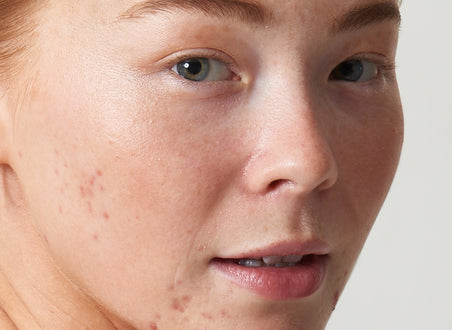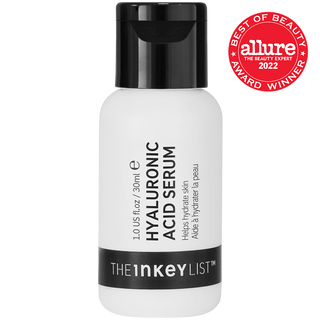Acne 101

Whether it plagues your teenage years or appears later in life, acne is a skin burden that can be painful and debilitating. From pus-filled pimples to their residing scars, it can sometimes feel like an exhausting battle against the breakouts. But don’t get the blemish blues. Understanding what causes these outbreaks and getting clued up on key ingredients that can help reduce their appearance, severity and spread, are the first steps to clearer skin.
WHAT IS ACNE?
Our pores, visible on the surface, connect to oil glands (technically known as sebaceous glands) beneath the skin through hair follicles which excrete sebum to the surface to keep it soft and prevent dryness.
When too much sebum is produced, it can clog and block the follicles with dead skin and dirt - introducing familiar friends: blackheads and whiteheads. When this congestion occurs, the pores can become inflamed or infected and angry pimples appear in the form of papules and pustules or, in severe cases, nodules and cysts. This is not only limited to the face, acne can strike across other areas of the body such as the back and chest. Find out more about how to get rid of back and chest acne here.
WHY DO I GET ACNE?
There’s a whole spectrum of causes of acne and much speculation about specific triggers including certain foods or behaviours. The most common identified causes of acne are hormonal changes (hence why commonly seen in teenagers), genetics and certain medications. Other lifestyle factors can contribute to clogged pore such as environment, products used or not drinking enough water. To explore potential causes, particularly with severe and long-term cases, we recommend consulting a doctor or dermatologist and making adjustments to different areas then monitoring their impact on your skin.
TYPES OF ACNE
Acne can manifest as a number of variants which are typically classified as non-inflammatory/comedonal acne (blackheads and whiteheads) which are closer to the skin’s surface and inflammatory which is caused when the normally harmless bacteria living on the skin finds its way into a congested follicle and causes infection. These tend to be more painful and severe outbreaks which require treatment, attention and a little bit of patience.
Blackheads (Open Comedones)
Pores are open but blocked and often look dark where the clogged sebum reacts with oxygen from air exposure.
Whiteheads (Closed Comedones)
Pores are closed and contain pus at the surface level of the skin. Generally smaller and not inflammed/red
Papules / Pustules
Sitting on the skin’s surface Papules (small red bumps) and Pustules (Small red bumps filled with pus on the skin surface) seem inflamed around the pores and more painful.
Nodules / Cysts
At the more severe end of the spectrum and deeper beneath the surface we encounter Nodules (Large, solid lumps) or Cysts (Painful pus filled lumps) which can be more aggressive, red and painful.
ACNE MYTHS
CLEANSE, CLEANSE, CLEANSE
Actually, acne is not necessarily caused by poor hygiene and over-cleansing can cause further irritation to sensitive spots so be careful and opt for key treatments to target. The same applies for using exfoliants as their abrasive nature may cause additional inflammation. Do make sure you wash your hands before and after your skincare routine to avoid transferring any dirt or bacteria and be aware of touching your face excessively throughout the day.
SQUEEZE SQUEEZE SQUEEZE
Squeezing pimples, especially those which are deeply set under the skin, can cause scarring requiring further treatment and attention. It can also encourage the spread of acne causing bacteria so RESIST THE URGE. Ingredients such as Succinic Acid Treatment and Salicylic Acid Cleanser can help unclog pores and reduce oil to help treat acne and breakouts.
ONLY TEENAGERS GET ACNE
Acne doesn’t discriminate by age, gender, or race. It can be more common in teenagers due to hormonal shifts but it’s certainly not exclusive. Changes to diet, environment and hormone shifts around pregnancy/menstruation can all cause sebum imbalance.
TOOTHPASTE CAN CURE YOUR ACNE
It’s a classic DIY suggestion passed down through generations but the fluoride in toothpaste can actually be detrimental to the skin. Ingredients such as Salicylic Acid are proven to be more effective for clearing blemishes so save the paste for those pearly whites.
CHOCOLATE CAUSES ACNE
Finally some good news - there is little to no scientific evidence to suggest that chocolate has any direct impact on the outbreak or severity of acne. That’s not to rule out diet as a whole however as there can be possibility certain food groups might impact an individual's symptoms of acne so it’s always worth exploring with a doctor or dermatologist.
YOU ONLY GET ACNE IF YOU HAVE OILY SKIN
As we’ve explored, acne and breakouts take many forms. Sure, oily skin has a tendency towards more excess oil which is a key component in the formula for a breakout, but it’s not exclusive. Knowing your skin type is a great way to prevent breakouts by incorporating products into your daily routine to keep it in balance such as controlling oil production and hydrating dry areas.
HOW TO GET RID OF ACNE - THE INKEY LIST ACNE ATTACKERS
So, what can you do? Whilst the key is tackling the root cause (which can be explored with a dermatologist or doctor) there are some amazing ingredients to help reduce and treat breakouts when they occur. Here are The INKEY List's best acne treatments;
SALICYLIC ACID
Salicylic Acid can work really well for breakouts. It’s oil soluble and can reach deep inside the pores, helping to reduce breakouts. With anti-inflammatory and anti-bacterial properties, it can also help spots fade quicker when they do arrive.
This hero ingredient can be found in The INKEY List Salicylic Acid Cleanser and The INKEY List Beta Hydroxy Acid Serum. Our Salicylic Acid Cleanser can be used AM and PM as the first stage of your routine whilst the Beta Hydroxy Acid Serum can be applied after cleansing and toning in the AM and PM helping to reduce breakouts and blackheads.
SUCCINIC ACID
Succinic Acid is a bio based chemical derived from corn and helps reduce the appearance of blemishes by helping to unclog pores and It can also help reduce acne bacteria on the skin, a usually harmless skin bacteria that can cause inflammatory acne when hair follicles become blocked.
Our hero acne spot treatment Succinic Acid Treatment contains 2% Succinic Acid which helps reduce the size of blemishes and decrease oil levels as well as 2% Sulfur Powder to further reduce excess oil and help unclog pores to aid in reducing future breakouts. This is a targeted treatment that can be applied directly to the spots for a fast-working impact.
NIACINAMIDE SERUM
A naturally occurring vitamin (B3), Niacinamide tackles the various side effects of spot prone skin such as redness and excess oil. The formula is made up with Hyaluronic Acid Serum to make sure it doesn’t strip the skin of hydration.
Our Niacinamide Serum is a hero for oil control and especially beneficial for oily or combination skin types. It contains 10% Niacinamide which helps to control excess oil, target blemishes and tackle redness and inflammation.
C-50 BLEMISH NIGHT TREATMENT
The C-50 Blemish night treatment works overnight to target breakouts. Its powerful combination of Vitamin C and Vitamin E helps reduce the bacteria count on your skin, helping prevent and reduce blemishes. Salicylic Acid also helps to exfoliate and unclog pores, while Lotus Extract helps to balance oil. This should be used in place of your moisturiser 2-3 times per week as the last stage of your PM routine and left on overnight to allow it to have maximum effect.
These treatments are designed for the face but can equally be applied to other areas of your body affected such as the chest or back. View our back and chest acne blog here.
ACNE PREVENTION
We’ve tackled the outbreaks, but you can also put preventative measures in place when your skin is clear and under control to ensure that there’s no nasty nodules brewing under the surface.
MANAGE STRESS
Research shows that stress can produce more oil-stimulating hormones.
DIET & EXERCISE
Keeping well and being conscious of your eating and drinking habits has a knock on effect to your skin. Monitor for any reactions or relation to your acne patterns to help target root causes of breakouts.
HYDRATION
Dehydration can tell the skin it needs to produce more oil which can start the vicious cycle of excess sebum. Don’t overexpose the skin to too much sun and incorporate hydrators such as Hyaluronic Acid Serum to keep it hydrated. This also applies to water consumption - aim for at least 3 litres per day.
CONTACTING A DOCTOR/DERMATOLOGIST
As we’ve explored, acne can have a wide number of causes and severe acne may require specialised and prescribed treatments. We always recommend consulting a doctor or dermatologist about your acne to investigate external factors that may be impacting your skin and the best mode of treatment for your individual needs.
For further questions, support or to create a tailored acne-busting recipe - contact the team at #askINKEY and sign up to our mailing list for the latest skincare updates.











